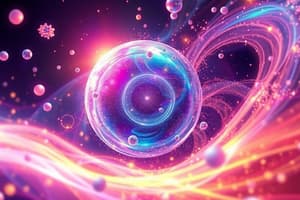Podcast
Questions and Answers
What happens to the kinetic energy of particles as temperature rises?
What happens to the kinetic energy of particles as temperature rises?
- It remains constant.
- It becomes negligible.
- It decreases significantly.
- It increases. (correct)
Which of the following best describes the process of diffusion?
Which of the following best describes the process of diffusion?
- The movement of particles in a vacuum.
- The separation of particles due to temperature changes.
- The spontaneous intermixing of particles on their own. (correct)
- The mixing of particles that occurs only under high pressure.
What inference can be made about the attraction between particles of matter?
What inference can be made about the attraction between particles of matter?
- Particles exhibit varying forces of attraction. (correct)
- Particles are always repelled by each other.
- Particles of matter never attract each other.
- Particles are held together in all cases by the same force.
What effect does heating have on the process of diffusion?
What effect does heating have on the process of diffusion?
In which scenario would particles be expected to hold each other with the greatest force?
In which scenario would particles be expected to hold each other with the greatest force?
What happens to particles of matter when they are heated?
What happens to particles of matter when they are heated?
Why does the surface of water remain together even when disturbed?
Why does the surface of water remain together even when disturbed?
Which of the following materials is least likely to exhibit strong particle attraction?
Which of the following materials is least likely to exhibit strong particle attraction?
What can be concluded about the number of particles in a crystal of potassium permanganate?
What can be concluded about the number of particles in a crystal of potassium permanganate?
What is observed immediately after adding a drop of ink to water?
What is observed immediately after adding a drop of ink to water?
What does the slow spreading of a substance in water suggest about the properties of particles?
What does the slow spreading of a substance in water suggest about the properties of particles?
In the activity with hot and cold water, what happens to the particles as time passes?
In the activity with hot and cold water, what happens to the particles as time passes?
What property of gases allows them to be compressed into a small cylinder?
What property of gases allows them to be compressed into a small cylinder?
What common characteristic is observed when mixing tea, coffee, or lemonade?
What common characteristic is observed when mixing tea, coffee, or lemonade?
How do gas particles contribute to the pressure exerted by a gas?
How do gas particles contribute to the pressure exerted by a gas?
How does temperature affect the rate of mixing particles in liquids?
How does temperature affect the rate of mixing particles in liquids?
What is the main reason that gases diffuse faster than solids and liquids?
What is the main reason that gases diffuse faster than solids and liquids?
What is a primary observation about the behavior of crystals when added to water?
What is a primary observation about the behavior of crystals when added to water?
Which of the following statements about the movement of gas particles is true?
Which of the following statements about the movement of gas particles is true?
What happens to the smell of a substance like Dettol during dilution?
What happens to the smell of a substance like Dettol during dilution?
What happens to the smell of food when it reaches our nostrils?
What happens to the smell of food when it reaches our nostrils?
What is the primary reason solids are considered rigid?
What is the primary reason solids are considered rigid?
In the syringe experiment, what do you observe when attempting to compress the contents?
In the syringe experiment, what do you observe when attempting to compress the contents?
Which gas is commonly used in vehicles due to its properties?
Which gas is commonly used in vehicles due to its properties?
How do liquids differ from solids in terms of shape and volume?
How do liquids differ from solids in terms of shape and volume?
What characteristic allows a rubber band to change its shape when stretched?
What characteristic allows a rubber band to change its shape when stretched?
What role does vaseline play when inserting the pistons back into the syringes?
What role does vaseline play when inserting the pistons back into the syringes?
Which of the following is true about the diffusion of sugar and salt in water?
Which of the following is true about the diffusion of sugar and salt in water?
What differentiates gases from solids and liquids regarding compressibility?
What differentiates gases from solids and liquids regarding compressibility?
Why can aquatic animals breathe underwater?
Why can aquatic animals breathe underwater?
What is the main reason liquids have a higher rate of diffusion than solids?
What is the main reason liquids have a higher rate of diffusion than solids?
Which statement best describes the properties of a sponge?
Which statement best describes the properties of a sponge?
What is the term used to describe the heat energy absorbed by ice without a rise in temperature during melting?
What is the term used to describe the heat energy absorbed by ice without a rise in temperature during melting?
Which state of matter has particles that are more energetic at 0°C?
Which state of matter has particles that are more energetic at 0°C?
What happens during the conversion of water to water vapor?
What happens during the conversion of water to water vapor?
What is the latent heat of fusion?
What is the latent heat of fusion?
During the phase change from solid to liquid, which of the following occurs?
During the phase change from solid to liquid, which of the following occurs?
What is the measurement used to indicate when the ice starts melting?
What is the measurement used to indicate when the ice starts melting?
Which of the following correctly identifies the change of state process for ice to water?
Which of the following correctly identifies the change of state process for ice to water?
What indicator would you observe when all the ice in a beaker has melted?
What indicator would you observe when all the ice in a beaker has melted?
Flashcards are hidden until you start studying
Study Notes
Characteristics of Matter
- Matter consists of particles that have space between them, allowing for movement.
- Particles of matter are always in motion, which is referred to as kinetic energy.
- As temperature increases, the kinetic energy of these particles increases, causing them to move faster.
Diffusion
- Diffusion is the process where particles of different substances intermix spontaneously by moving into the spaces between each other.
- The rate of diffusion increases with temperature, leading to faster movement of particles.
Behavior of Solids, Liquids, and Gases
- Solids have a fixed shape and volume; they are difficult to compress and maintain shape under force.
- Liquids have a fixed volume but take the shape of their containers; they can flow easily and are less rigid than solids.
- Gases are highly compressible with large spaces between particles, allowing them to be packed into small volumes.
Activities Demonstrating Particle Behavior
- Mixing substances like sugar, salt, or potassium permanganate into water shows that particles can spread out and mix due to their inherent movement.
- Particles of matter are extremely small, which can be illustrated by adding a drop of ink or honey to water and observing how they disperse.
Compression and Pressure
- The compressibility of gases allows a large volume of gas to be compressed into small cylinders (e.g., LPG and CNG for cooking or fuel).
- The pressure of gases arises from particles colliding with the walls of their container.
States of Matter Transformation
- Matter can exist as solid (ice), liquid (water), or gas (water vapor).
- The process of changing from solid to liquid (melting) or from liquid to gas (vaporization) involves energy input which alters the particle movement and arrangement.
Hidden Energy and Latent Heat
- During phase changes, such as melting ice or boiling water, the energy absorbed is termed latent heat; it does not increase temperature during the phase conversion.
- For example, latent heat of fusion is the heat energy required to change a solid into a liquid at atmospheric pressure.
Conclusion
- Understanding the properties and behavior of particles in different states of matter is crucial for grasping fundamental scientific concepts related to chemistry and physics.
Studying That Suits You
Use AI to generate personalized quizzes and flashcards to suit your learning preferences.




